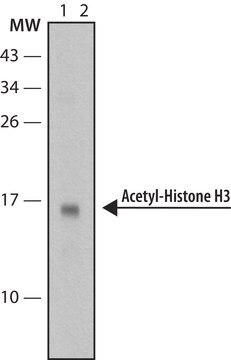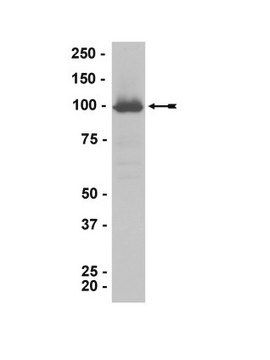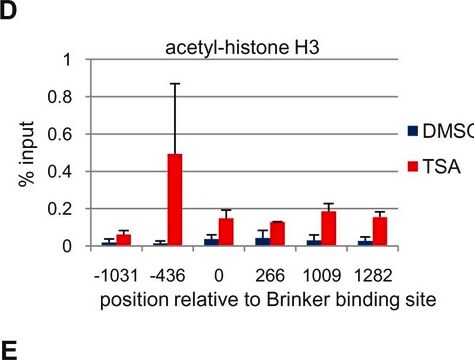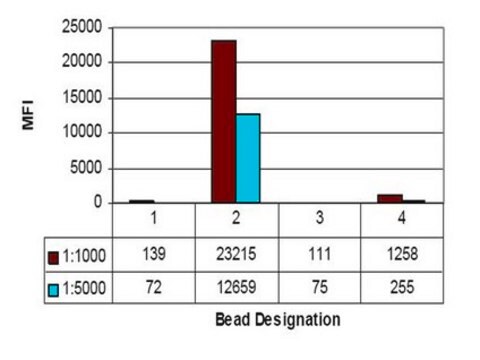07-355
Anticorpo anti-acetil-istone H3 (Lys23)
serum, Upstate®
Sinonimo/i:
H3K23Ac, Histone H3 (acetyl K23)
About This Item
Prodotti consigliati
Origine biologica
rabbit
Livello qualitativo
Forma dell’anticorpo
serum
Tipo di anticorpo
primary antibodies
Clone
polyclonal
Reattività contro le specie
Saccharomyces cerevisiae, human, vertebrates
Produttore/marchio commerciale
Upstate®
tecniche
ChIP: suitable
dot blot: suitable
western blot: suitable
N° accesso NCBI
N° accesso UniProt
Condizioni di spedizione
wet ice
modifica post-traduzionali bersaglio
acetylation (Lys23)
Informazioni sul gene
human ... H3C1(8350)
Descrizione generale
La coda N-terminale dell′istone H3 fuoriesce dal centro globulare del nucleosoma e può subire diversi tipi di modificazioni epigenetiche che influenzano i processi cellulari. Tali modificazioni comprendono l′attacco tramite legame covalente dei gruppi metile o acetile agli amminoacidi lisina e arginina e la fosforilazione della serina o della treonina.
Specificità
Immunogeno
Applicazioni
Epigenetica & funzione nucleare
dati ottenuti con un lotto rappresentativo.
La cromatina sonicata preparata da cellule HeLa (equivalenti a 1 X 10E6 cellule/IP) è stata immunoprecipitata usando 2 µL di siero di coniglio normale o 2 µL di anticorpo anti-anti-acetil-istone H3 (Lys23) e il kit Magna ChIP A (N° Cat.17-610). L′avvenuta immunoprecipitazione dell'acetil-istone H3 (Lys23) è stata confermata mediante qPCR utilizzando primer di controllo specifici per la regione del promotore del gene GADPH umano come locus positivo e i primer di Myo-D come locus negativo. I dati sono presentati come input percentuale di ciascun campione IP rispetto all′input di cromatina per ciascun amplicone e campione CHIP come indicato.
Per la descrizione dell'esperimento, consultare il protocollo del kit EZ-Magna ChIP A (N° Cat. 17-408) o EZ-ChIP (N° Cat. 17-371).
Western blotting:
Dati ottenuti con un lotto rappresentativo.
Gli estratti acidi di cellule HeLa trattate con butirrato di sodio (corsia 1, N° Cat. 17-305) e l'istone H3 ricombinante (corsia 2, N° Cat. 14-494) sono stati esposti all'anticorpo anti-acetil-istone H3 (Lys23) (diluizione 1:100.000).
Le frecce indicano l′anti-acetil-istone H3 (circa 17 kDa)
Dot Blot:
Dati ottenuti con un lotto rappresentativo.
Quantità pari a 40 ng e 4 ng di peptidi istonici con varie modificazioni (vedere tabella 1) sono state trasferite su una membrana di PVDF ed esposte all'anticorpo anti-acetil-istone H3 (Lys23) (diluizione 1:2000). Le proteine sono state visualizzate mediante un anticorpo di capra anti-IgG di coniglio coniugato con HRP e un sistema di rivelazione per chemiluminescenza. L'immagine è stata ottenuta con 60 secondi di esposizione.
Istoni
Qualità
Descrizione del bersaglio
Stato fisico
Stoccaggio e stabilità
Risultati analitici
Estratti acidi ottenuti da cellule HeLa trattate con butirrato di sodio
Note legali
Esclusione di responsabilità
Non trovi il prodotto giusto?
Prova il nostro Motore di ricerca dei prodotti.
Codice della classe di stoccaggio
10 - Combustible liquids
Classe di pericolosità dell'acqua (WGK)
WGK 1
Certificati d'analisi (COA)
Cerca il Certificati d'analisi (COA) digitando il numero di lotto/batch corrispondente. I numeri di lotto o di batch sono stampati sull'etichetta dei prodotti dopo la parola ‘Lotto’ o ‘Batch’.
Possiedi già questo prodotto?
I documenti relativi ai prodotti acquistati recentemente sono disponibili nell’Archivio dei documenti.
Il team dei nostri ricercatori vanta grande esperienza in tutte le aree della ricerca quali Life Science, scienza dei materiali, sintesi chimica, cromatografia, discipline analitiche, ecc..
Contatta l'Assistenza Tecnica.








